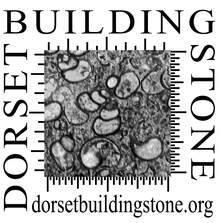Building stones used in Dorset are sedimentary and result from the deposition of sand, mud or lime-mud in water. The texture of the building stones is a result of the variability of their environment of deposition. In addition to the movement of continents, climates and sea levels have changed many times over millions of years. During the Jurassic and Cretaceous periods what is now the European continent was closer to the Equator than today. The water was considerably warmer and extended over the continental margins, where limestones formed by biological, biochemical and to a lesser extent organic precipitation. Limestones are defined as consisting of over 50% calcium carbonate. There may be lesser amounts acting as cement in sandstones, or as a constituent of mudstones.
Dorset Geology - Geological Names and Ages of Rocks used for Buildings and Other Purposes
A summary sheet "Dorset Geology - Geological Names and Ages of Rocks used for Buildings and Other Purposes" can be downloaded as a pdf below.
| dorset_stratigraphy_mk_ix__02-feb-2017_gt.pdf | |
| File Size: | 526 kb |
| File Type: | |
Limestones
Limestones are divided into three major groups, chemical, organic or detrital. Chemically precipitated limestones can be formed by the precipitation caused by evaporation of calcium carbonate from warm shallow water, or by coating sand grains, algae or small scraps of shell with layers of calcium carbonate to form ooliths. Organic limestones consist mostly of the remains of plants and animals, which had shells or skeletons of calcium carbonate. Except for the Chalk, the individual limestone beds used for building are usually less than 1 metre thick. The thickest beds, such as those from the Portland Freestone, are cut as ashlar, while the thinner beds may be broken or dressed by hand. Some of them are rich in the fossil remains of ammonites, belemnites, bivalves, gastropods, brachiopods and occasionally plants. The larger fossils may create weak points in a rock which make it unsuitable for building stone. An even-textured limestone which may be cut and placed in any direction is known as a freestone.
|
Chalk
Chalk is the purest example of an organic limestone, consisting almost entirely of the calcareous skeletons of coccoliths (a floating alga). Other organic limestones are largely made up of the shells of bivalves, gastropods, ammonites etc., or corals, algae, crinoids (small colonial animals with calcite skeletons) or foraminifera (microscopic plankton made of calcite).
Sandstones
Sandstones consist mostly of grains of silica sand, of varying sizes and degrees of roundness, from sharp-edged to completely rounded. They may have high porosity with empty pore spaces, or be cemented with calcium carbonate; iron coated finer grains (ferruginous), or even wholly cemented together with re-crystallised silica (silcrete). Glauconite, a complex mineral including iron and aluminium that indicates a marine, near-shore sea floor environment, occurs as isolated grains in the Upper Greensand and lowest Chalk beds.
|
Detrital limestones
Detrital limestones are made up of fragments of pre-existing limestone, or organic carbonate. The fragments are cemented together either with micrite (calcite material which has a grain size less than 0.01 millimetre) or with sparite (coarse crystalline calcite replacing micrite or filling spaces, which has a grain size more than 0.01 millimetre). This is often known as ‘sparry’ calcite, and gives a crystalline appearance to the rock. Shorthand words for describing shelly limestones include:
BIOMICRITE – a limestone consisting mostly of shells (bio) with very fine calcium carbonate (micrite) surrounding the fragments. BIOSPARITE – a limestone consisting mostly of shells (bio) with crystals of calcite (sparite) cementing the shells together. Clays
Clays are the finest grained of all the rocks and have a crystal structure which forms as horizontal plates, giving them a tendency to slip when wet, but binds them together when baked as bricks or pottery.
|
The effects of weathering on building stone
The texture of stone, including the type of grains and the way they are packed or cemented together, governs the weathering properties over hundreds of years. When studying buildings it is often the characteristic effect of weathering which gives us our first clue on the geology. Expert examination through a microscope will eventually tell us so much more about the chemistry and environmental conditions in which any kind of stone is formed. But this depends on cutting stone that is a certain match or which is only occasionally available from building construction or repairs and from waste, or other building detritus.

